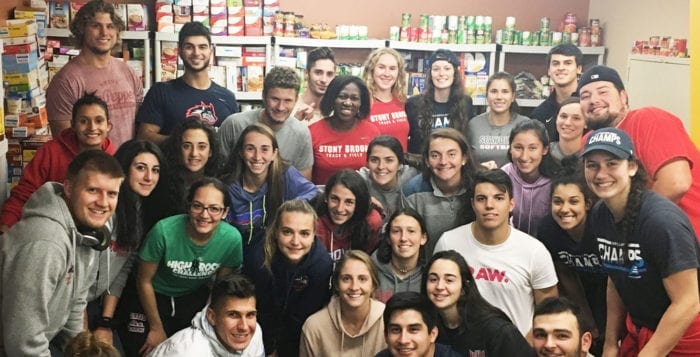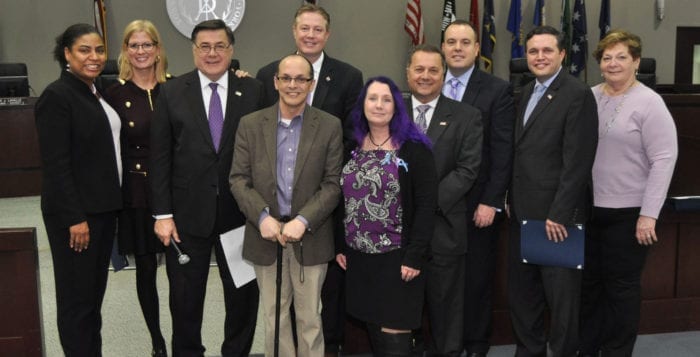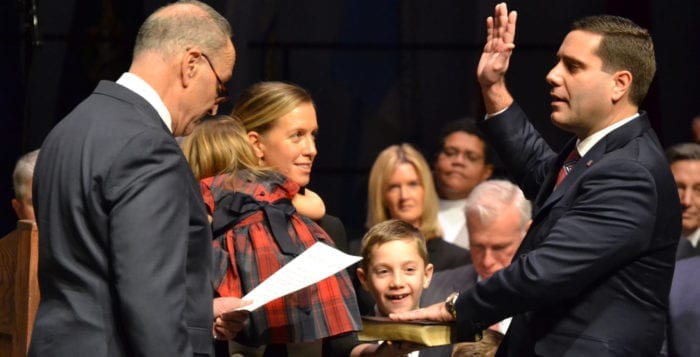Stony Brook University is ahead of the curve when it comes to ensuring students are well nourished.
In December, New York Gov. Andrew Cuomo (D) unveiled a proposal of the 2018 State of the State that includes the No Student Goes Hungry Program. The five-point plan was conceived to combat hunger and food insecurity for students in kindergarten through college. If legislation is passed, all State University of New York and City University of New York schools will be required to offer a food pantry on their campuses or enable students to receive food through stigma-free means — something SBU has been doing since 2013. Currently half of all SUNY and CUNY campuses offer food pantries, according to the governor’s office.
“This program is essential to the success of future New York leaders and this administration remains committed to removing barriers to healthy food options, while providing a supportive, effective learning environment for students across this great state,” Cuomo said in a statement.
According to Hunger on Campus, a report and survey conducted by a number of national campus organizations, 48 percent of college-aged respondents to surveys experienced food insecurity within 30 days.

SBU clinical assistant professor Donna Crapanzano, pantry co-director since 2016, said associate professor Carlos Vidal of the School of Health Technology and Management brought the idea to the university in 2011. Since it opened in 2013, the pantry has provided food donated by members of campus organizations to 4,100 food-insecure students, faculty and staff members. Currently open 10 hours a week in the university’s Information Technologies Study Center at the Grey College building, approximately 20 student volunteers man the pantry, and there are plans to expand operating hours in the spring.
“I think it’s a great initiative,” Crapanzano said. “One of the things that’s really important to me, and I joke about this all the time with students, is I believe the first thing of your day should be breakfast. You can’t get a good day started if you’re not fueled up, and your brain doesn’t work without having fuel. So, [Cuomo’s] initiative is starting with pre-school and going through 12th grade and then to extend that because you’re still a student, you’re still being educated. We know that food is a primary source of you not only succeeding in your academics but eventually succeeding in the workforce.”
To use the SBU food pantry, one only needs to provide a school identification card.
“One of our goals was to really make it an environment where you don’t have to have any other reason other than being a SBU student, faculty or staff, because one day may be different from another day,” Crapanzano said. “It’s not based on overall finances, it’s based on what the needs are in your life at the time.”
The professor said she and fellow director Richard Sigal, SBU’s assistant director for college housing for Roth Quad, have worked with a nutritionist to provide balanced choices to pantry visitors, and each guest to the pantry receives a fruit, vegetable, protein and a carbohydrate. The food pantry asks for nonperishable food items that contain less than 30 percent of the overall daily intake of sodium and 25 grams or less of sugar. If donated food includes higher amounts of salt and sugar, it is placed on a “junk” table where volunteers will remind a person taking it to make sure it is balanced with something nutritious. Crapanzano said one example is cutting Ramen noodles with another type of pasta or beans.
“We do our best to educate the guests who come to know what are better ways for them to make a healthy eating choice when they can,” she said, adding that volunteers adiscuss food labels with pantry guests so they know what to look for when they shop on their own.
“It’s not based on overall finances; it’s based on what the needs are in your life at the time.”
— Donna Crapanzano
Crapanzano said every academic year an intern works with the directors. Since the fall semester of 2017, SeungJu Lee, a graduate student in social welfare, has been collaborating with them on projects such as creating more community outreach.
“I didn’t know we had this pantry at first, [until] I became a social work student,” Lee said. “Many students aren’t aware about our food pantry. So we’re trying to do many promotions and give awareness of food insecurity and the food pantry.”
The graduate student said it has been a positive experience for her, and she has met many people from the university community.
“The food pantry is an informal place where we welcome guests and make small talk with them,” Lee said, adding that volunteers and patrons often will discuss classes.
One experience she said she will always remember is a conversation with a college staff member who donated food, telling Lee she once needed help from various social welfare agencies and now wanted to pay it forward.
Crapanzano said there have been a number of people who have used the pantry in the past and have later come back to volunteer.
“It’s full circle,” she said. “You help out somebody and then they return the help, and then you develop a relationship that you know helped that person get a little bit further because they just needed something at that time.”



























